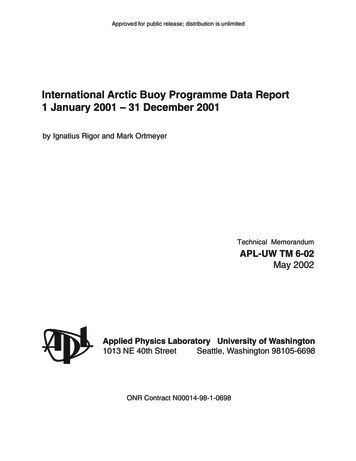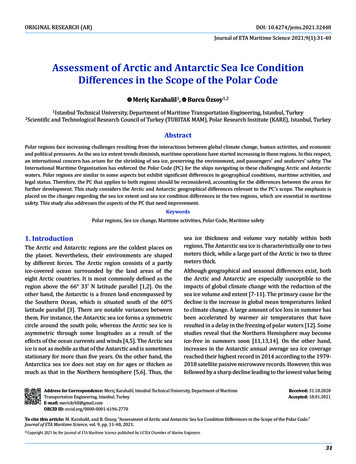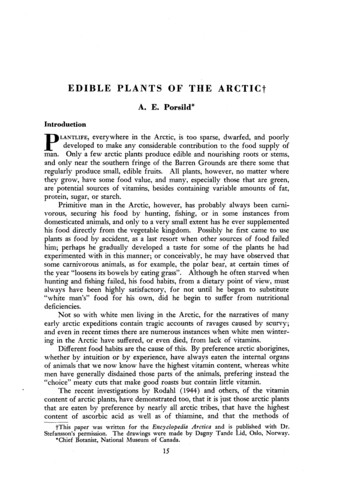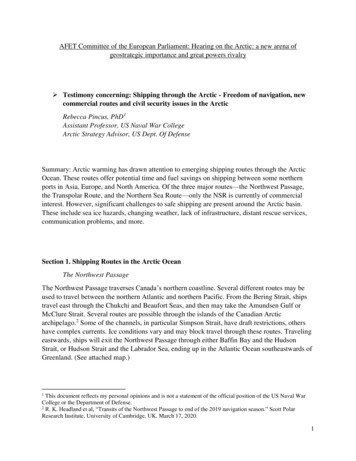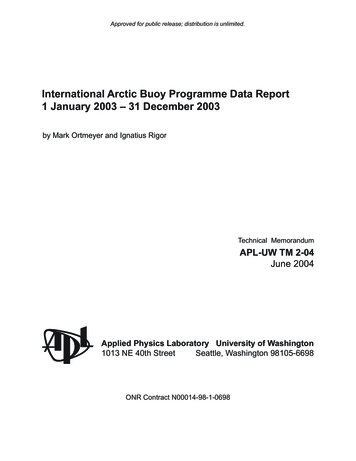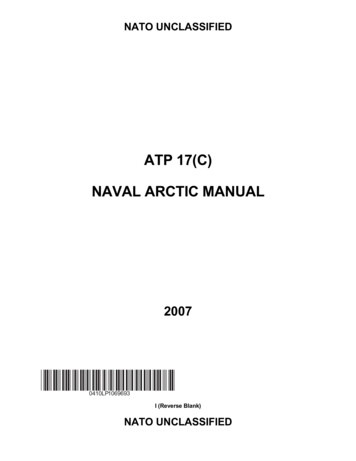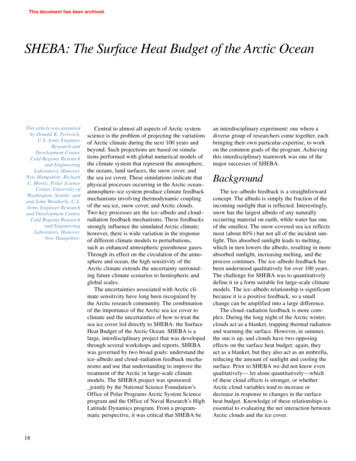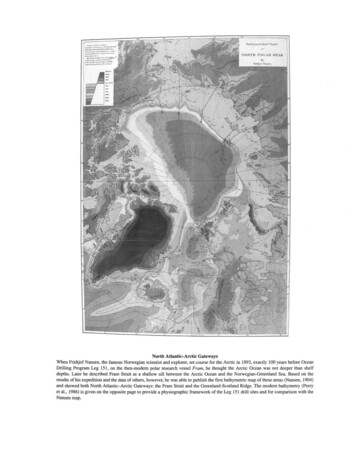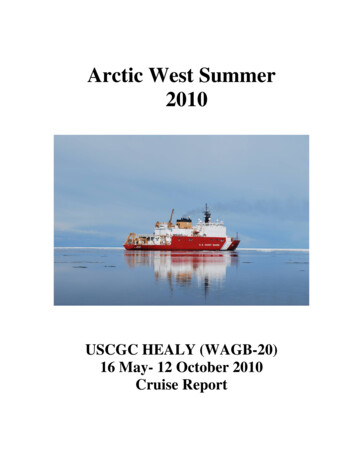
Transcription
Arctic West Summer2010USCGC HEALY (WAGB-20)16 May- 12 October 2010Cruise Report
Front Cover: HEALY as seen from her small boat in Kotzebue Sound, AK.2
3
Table of ContentsI. Ship Operations 5A. Chronological Events .5B. Vessel Operations 6II. Deck Operations .12III. Air Operations 21IV. Navigation .26V. Communications .33VI. Science Operations 34VII. Engineering .43VIII. Administration .86IX. Morale .88X. Supply/Logistics . 93XI. Medical .102XII. Public Relations .104XIII. Personnel Embarked .1094
I. Ship OperationsA. Chronological Events16 May 1024 May 1031 May 1011 Jun 1012 Jun 1014 Jun 1015 Jun 1018 Jun 1018 Jun 1027 Jun 1028 Jun 1016 Jul 1016 Jul 1019 Jul 1021 Jul 1021 Jul 1028 Jul 1031 Jul 1031 Jul 1002 Aug 1002 Aug 1004 Aug 1004 Aug 1016 Aug 1030 Aug 1006 Sep 1024 Sep 1024 Sep 1026 Sep 1027 Sep 1029 Sep 1029 Sep 1001 Oct 1003 Oct 1005 Oct 1009 Oct 1011 Oct 1012 Oct 1012 Oct 10Departed Seattle Pier 36Moored Honolulu Aloha TowersDeparted HonoluluStood into Bering Sea at Unimak PassMoored Dutch Harbor UMC PierEmbarked HLY-10-01 Science PartyDeparted Dutch HarborStood into Arctic Ocean at Bering StraitCrossed Arctic Circle at 167-51.2 West LongitudeConducted ice liberty for crewConducted passenger transfer at BarrowCrossed Arctic Circle at 168-46.1 West LongitudeStood into Bering Sea at Bering StraitStood in Gulf of Alaska at Unimak PassMoored Seward Alaska Railroad Cargo DockDisembarked HLY-10-01 Science PartyDeparted SewardStood into Bering Sea at Unimak PassMoored Dutch Harbor UMC PierEmbarked HLY-10-02 Science PartyDeparted Dutch HarborStood into the Arctic Ocean at Bering StraitCrossed Arctic Circle at 168-16.5 West LongitudeConducted passenger embarkation via small boat at BarrowTransferred personnel to LOUIS S. ST. LAURENT for MedevacDisembarked HLY-10-02 via helicopter from Barrow;Embarked HLY-10-03 via helicopter from BarrowCrossed Arctic Circle at 168-38.5 West LongitudeStood into Bering Sea at Bering StraitMoored Dutch Harbor UMC PierDisembarked HLY-10-03 Science PartyDeparted Dutch HarborStood into Gulf of Alaska at Akutan PassMoored Kodiak Pier 2Departed KodiakMoored Juneau South Franklin DockDeparted Juneau for Dependents CruiseEmbarked pilots for transit of Inside PassageDisembarked pilotsMoored Seattle Pier 365
B. Vessel OperationsThe 2010 deployment scheduling was commenced by HEALY during thesummer of 2009. The principal concerns shaping the 2010 schedule were thetotal number of days away from homeport (DAFHP), the triennial drydocking’simpact on the total DAFHP, aligning with PACAREA Port Call standards &offering the crew opportunities at ports other than Dutch Harbor. Workingwith PACAREA and Headquarters the final schedule reflected 153 DAFHPduring fiscal year 2010.With the largest constraints established, a notional schedule was produced inlate July 2009. The 2010 science missions contained two familiar missions andone entirely new mission as compared to 2009. It included a five week NASAmission, a five week joint National Oceanic Atmospheric Administration(NOAA) and the U.S. Geological Survey (USGS) for the United NationsConvention on the Law of the Sea (UNCLOS) – Extended Continental Shelf. Acopy of the full schedule is provided in Appendix (1), with a summary providedbelow in Table 1. A graphical briefing of the schedule is provided in Appendix(3). Concept of operations (CONOPS), operations orders (OPORD), anddeployment summaries (DEPSUM) are provided in Appendix (4), and areavailable upon request.Table 1. Arctic West Summer 2010 (AWS-10) Schedule7 Apr – 16 Apr19 Apr – 22 Apr16 May – 24 May25 May – 30 May31 May – 12 Jun14 Jun – 22 Jul23 Jul – 27 Jul28 Jul – 31 Jul02 Aug – 06 Sep07 Sep – 28 Sep29 Sep – 12 OctShakedownAviation Standardization (STAN) Team VisitTransit from Seattle to HonoluluMPB Honolulu, HIMultibeam System Acceptance Test Enroute Dutch HarborAWS-10-01 NASA ICESCAPEMPB Seward, AKTransit from Seward, AK to Dutch Harbor, AKAWS-10-02 Arctic ECSAWS-10-03 North slope mooringsTransit from Dutch Harbor to Seattle via Kodiak & JuneauShakedown, 07 April – 16 AprilFrom April 7th thru April 16th HEALY performed its annual shakedownfollowing the winter drydock maintenance availability. The shakedownschedule is provided in Appendix (2). As standard, vendor work acceptancetrials were performed, grooms were conducted on various systems, andemergency drills were conducted. An aggressive training and science systemshakedown was scheduled and largely achieved. Nearly all of the intendedscience evolutions were completed, including time spent in the vicinity of theNOAA weather buoy in the Strait of Juan de Fuca for sensor calibration. At theconclusion of Shakedown, a comprehensive list of pending issues, both shortterm (crucial for AWS-10) and long term, was assembled and used to guidework efforts leading up to the AWS-10 deployment.6
Aviation Standardization (STAN) Visit, 19 April – 22 AprilRepresentatives of the Ship-Helo Standardization Team from Aviation TrainingCenter (ATC) Mobile conducted the inport portion of the visit pierside at BSUSeattle 19-20 April, followed by a one-day underway period conducting flightoperations with an Air Station Port Angeles HH65. HEALY successfullycompleted the visit and associated qualification. The final report of the ShipHelo STAN Team is attached as Appendix (5).An HH-60J from AIRSTA Barbers Point prepares to land on HEALY’s flight deck duringflight operations conducted off the coast of Hawaii.Transit from Seattle to Honolulu, 16 May – 24 MayThe transit from Seattle to Honolulu was largely uneventful. Somecycloconverter problems resulted in engineering troubleshooting efforts andonboard techs continued to run the new EM122 Multibeam sonar to assess itsperformance prior to the formal acceptance testing planned for the next transitleg.Requests for flight operations with both Air Station Astoria and Air StationBarbers Point were accommodated, requiring faster transit speeds thanoriginally planned. HEALY moored on time at Aloha Tower in Honoluluharbor the morning of Monday, 24 May, and the crew enjoyed a week of libertysomewhere other than Dutch Harbor in preparation for the 5 monthdeployment. Tours for the public in Honolulu were conducted for two hourseach on two different days.7
Multibeam System Acceptance Test & Dutch Harbor Transit, 31 May – 12JuneSince weather cut short the flight operations conducted prior to mooring inHonolulu, they were rescheduled for the day of departure – however weatheronce again cancelled the operations.During the northbound transit, several areas were chosen in various depths ofwater and bottom characteristics to evaluate the multibeam performance tosupport a formal acceptance decision. Recurring failure of several circuitboards necessitated a fast run north and boat operations at Dutch Harbor toretrieve addition spare parts to facilitate completion of the testing. Testing wascompleted on time and the EM122 multibeam was recommended to beaccepted on 12 June.AWS-10-01 37-day NASA ICESCAPE Mission (Arrigo), 14 June – 22 JulyThe NASA Impacts of Climate on EcoSystems and Chemistry of the ArcticPacific Environment (ICESCAPE) mobilized in Dutch Harbor on 14 June.This group was very large, at 48 personnel and they had a large amount of gearto set up – including sensors on the bow platform, in the Arctic Survey Boat, ona new collapsible mast above the bridge, and in every available lab spaceonboard. Setting up continued for a couple days during the transit north andprior to first operations in the Bering Strait.Key components of this mission included open water stations consisting ofsequenced deployment of multiple sensors from HEALY, as well as launch ofthe ASB at selected stations. A third focus was on-ice deployments ofapproximately 12 personnel for optical measurements, ice analysis & under-icewater sample collection. In general, investment of additional time during thenorthbound transit to exchange information about station expectations andship/ASB limitations may have improved station efficiency, however weultimately exceeded objectives based on numbers of stations occupied, bothopen water and on-ice.Pre-cruise planning was critical to the success of this mission, includingfocused efforts to retain departing crewmembers, arranging early-arrival ofsome new crewmembers, utilizing 1/c cadets onboard to supplement the bridgewatch and keeping the boat operators out of the standard watch rotation toincrease flexibility for boat and on-ice operations. Without these measures,HEALY’s optimal crew size would have difficulty supporting this mission withthe flexibility we did this year.The on-ice deployments during this mission were different from on-icedeployments from HEALY during the past few years in that the scientists wereseeking ice floes in the midst of the spring melting process. As a result,positioning of the ship to allow access to suitable ice without destroying thefloe was a challenge and OODs had to learn how to bring the ship to rest on ice8
that is thinner than spring ice, which is generally thicker/harder and not yet inthe midst of melting. OODs worked with science personnel to identify ice thatwould meet the needs of the science party, be safe for deploying people, andwhich the OODs would be able to partially pull the ship onto, allowing the iceto hold the ship steady without cracking the ice. As a result of lessons learned& interaction with highly experienced sea ice personnel in the science party,HEALY’s on-ice instruction will be revised and expanded to address this typeof ice deployment.NASA was demobilized and all gear offloaded in Seward, AK. This requiredmore than one day to accomplish all work and our arrival eight hours earlyallowed the extra time necessary to complete the demobilization by COB on 22July.Mid-Patrol Break in Seward & Transit to Dutch Harbor, 23 July – 31 JulyThe crew enjoyed a six day mid-patrol break in Seward, AK with manyexploring the outdoor activities in the area, traveling to Anchorage andenjoying the hospitality of the local VFW Post.Departure from Seward was timed to take advantage of the high tide on 28 Julyand a Man Overboard (shipboard recovery) drill was conducted for theobservation and critique of the embarked Afloat Training Group (ATG) LiaisonOfficer. The ATG officer also observed an Integrated Training Team drill andoffered critique, performing a miniature Limited Team Training which willhelp in HEALY preparations for the FY11 CART/TSTA cycle.HEALY moored on time in Dutch Harbor for logistics, fueling andmobilization of the Arctic ECS mission on 02 August.HEALY crewmembers participate in a community service project during the mid-patrol breakin Seward, AK9
AWS-10-02 34-day Arctic ECS Mission (Edwards), 02 August – 06SeptemberThe Arctic Extended Continental Shelf (ECS) mission mobilized on time anddeparted Dutch Harbor in the afternoon on 02 August. During the northboundtransit, planning began immediately for the planned coring and dredgingoperations. This early investment paid dividends when HEALY arrived a bitearlier than expected near the planned rendezvous point at the US-Canadianborder, and CCGS LOUIS S. ST. LAURENT (LSSL) was delayed – allowingthe completion of one gravity core and two very successful piston cores – oneof which recovered a rare Arctic gas-hydrate sample.Following rendezvous with LSSL, an unfortunate injury to a LSSLcrewmember required their return east for a medevac, resulting in a furtherdelay of operations. Later, after completion of the first survey lines in ice inthe US EEZ, HEALY was able to run south to Barrow and recover areplacement crewmember and mission-critical parts for LSSL while theycontinued seismic survey of lines in open water. The joint operation resumedjust prior to LSSL re-entering the ice and continued to allow steady progressnorthward along the cruise track.Approximately halfway through the mission, LSSL experienced an engineeringcasualty which required approximately 24 hours of work on their starboardshaft thrust bearing. During this period, HEALY continued northboundmultibeam mapping and conducted a piston core and CTD in the deep CanadaBasin. Both vessels rendezvoused about 2 days later and resumed joint seismicsurvey operations on an eastbound line in the vicinity of 82 North latitude.Prior to reaching the 2500 meter depth contour on this line near the QueenElizabeth Islands, a LSSL crewmember fell seriously ill, requiring both vesselsto divert southbound enroute Tuktoyaktuk for a medevac. Heavy ice conditionsin this area initially challenged both vessels for about 48 hours, after whichtime transit speeds improved. A subsequent injury to a HEALY crewmemberduring this transit resulted in the HEALY patient and an escort beingtransferred to LSSL for transfer ashore in Tuktoyaktuk and commercial travelback to Seattle for more robust specialized care. HEALY conducted two pistoncores and a deep CTD while awaiting LSSL return from the medevac, at whichtime both vessels completed one final east to west seismic line just northwest ofBanks Island before parting ways early morning on 04 September.This mission was safely demobilized by helicopter off Barrow, AK on 6September.AWS-10-03 20-day North Slope Moorings (Pickart), 07 September – 28SeptemberThe North Slope Mooring mission began mobilizing by helicopter from Barrowthe morning of Labor Day, September 6th. Visibility & sea conditions wereideal, allowing HEALY to anchor & conduct flight operations throughout the10
day – demobilizing the 10-02 mission and mobilizing the 10-03 mission (60 personnel transfers and 10,000 lbs of food and cargo) in a record 8 hours.HEALY was on-mission conducting a bathymetric survey of Barrow Canyonby midnight.The operational description provided in the cruise planning form is:The primary mission of this cruise is to service moorings as part ofseveral on-going programs and to carry out hydrographic measurementsfor the yearly assessment of the western Arctic Boundary Current. Thearea of operations will be the vicinity of Barrow Canyon and theBeaufort shelf and slope as far east as 134W. In addition, we willdeploy a meteorological station on the pack ice in the southern Canadabasin.The missions was highly successful, meeting or exceeding all missionobjectives, with the exception of one HARPS mooring which failed to surfaceafter the hydrostatic release was commanded. It is suspected to be stuck in themud and bottom sediment. All other mooring recoveries and deployments weresuccessful. During the mission 172 CTD casts were completed, which is 15%more than the stated goal of 150 casts – producing the first comprehensivesectional CTD survey of the Western Arctic Boundary Current from Barrow tothe entrance of the Amundsen Gulf. One final unique aspect of this missionwas the deployment of an autonomous weather station on an ice floe, whichalso provided one last ice liberty opportunity for the deployment. This weatherstation unfortunately stopped transmitting 24 hours after deployment, withpolar bear damage being the most likely cause.A polar bear as seen from HEALY11
Transit from Dutch Harbor to Seattle, 29 September – 12 OctoberThe transit from Dutch Harbor began early the morning of September 29th.After a difficult unmooring in very gusty winds to 30 knots, and transit northout of Dutch Harbor in 20 foot seas, a quick jog through Akutan Pass led tomuch calmer seas. The afternoon of 30 September provided just a short periodof ideal weather for DLQs with an Air Station Kodiak H60, however winds andclouds slowly increased during the training in the early evening, leading tobuilding seas overnight. Toward the end of the training DLQs, the H60experienced a loss of engine power forcing an emergency landing on deck. Thehelicopter was secured on deck and offloaded by crane on 02 October, aftermooring in Kodiak on 01 October.HEALY departed Kodiak on 03 October enroute Juneau, beating across theGulf of Alaska just ahead of a developing storm and mooring in Juneau theafternoon of 05 October at the South Jackson Dock. Original plans hadHEALY mooring at the CG mooring, however due to sketchy informationabout the depths alongside the CG pier and an extremely low -3.9 foot tideduring our stay, we opted for the 45 foot confirmed depths alongside the SouthJackson Dock. We used a 45 foot brow provided by the pier and ran it from the6 foot platform on the pier to the flight deck, which worked well for the 25 foottidal range experienced during our stay. The brow was very steep at high tide,however with only adjustment of the platform on the pier, the brow remainedconnected & accessible throughout the 4 day stay.After departing Juneau, HEALY transited Stephens Passage, Frederick Sound,and Chatham Straits to Cape Decision before nightfall. HEALY transitedSumner Strait to Stikine Strait, going around Zarembo Island, during the night.Clarence Strait, Dixon Entrance, and Hecate Strait consumed the next day. AtPine Island HEALY embarked two Canadian pilots. The pilots conned thecutter through Johnstone Strait, Seymour Narrows, and Strait of Georgia toHaro Strait and then to Victoria. The transit with pilots took about 18 hours.After disembarking the pilots, HEALY returned to Seattle via transit of PugetSound.II. Deck OperationsThe following table documents the dates and durations of small boatdeployments. The “11” and “10” are HEALY’s rigid-hull inflatable boats, andthe “251” is the Arctic Survey Boat (ASB).Table 2: Small Boat Sortie LogSortieDateType16-May Ops3-Jun Morale8-Jun OpsExact MissionTraining/RecoverySwim CallParts Run(Dutch Harbor)12BoatTime11 1h00m11 1h30m11 1h30m
psOpsOpsOpsOpsOpsTrainingData CollectionData CollectionData CollectionData CollectionData CollectionData CollectionData CollectionData CollectionData CollectionData CollectionData CollectionData CollectionData CollectionData CollectionData CollectionData CollectionData CollectionData CollectionMOB DrillPAX TransferParts Run (Barrow)Mooring RecoveryMooring RecoveryMooring RecoveryMooring RecoveryMooring RecoveryAir Drop RecoveryMooring RecoveryLine 0m40m1hr25m1hr10m35m1hr10m1hr00mA. Seattle, WA to Honolulu, HI (HLY-10-TB) (16 May to 24 May)During the transit from Seattle to Honolulu, HI, deck operations were minimal,and Deck Division focused on preparing for the summer and on the flightoperations discussed in their respective sections of this report. On 16 May,224711 was recovered and cradled after it and HEALY departed Pier 36. Priorto being recovered, small boat engineering training was conducted on 11.B. Moored in Honolulu, HI (24 May to 31 May)While in Honolulu, Deck Division assisted in preparations for the upcomingmissions. They onloaded a total of six picks, weighing in at a total of 3400 lbs.13
The picks consisted of the 1400lb Accommodation Ladder, a pump (500 lbs),and 4 pallets for GSK (1500 lbs total).Deck division makes preparations to get underway for AWS-10C. Honolulu, HI to Dutch Harbor, AK (HLY-10-TC) (31 May to 12 June)While on the way to Dutch Harbor, AK from Honolulu, HEALY conducted aswim call. Members of Deck Division assisted in making this possible bystanding shark watch from the bridge and from 224711, and standing by as arescue swimmer. After the small boat operations, MK1 Myers received hisqualification as CB-L Engineer. After the swim call, Deck Division assisted intesting new cutter rescue swimmer equipment. This equipment consisted of ablock on the starboard A-frame and rigging to allow lowering of a rescueswimmer and recovery of a stokes litter from the starboard A-frame –HEALY’s primary shipboard recovery man overboard station. A major findingof this test was that recovery of an unconscious man overboard in rough seasusing a stokes litter will be impossible for a single rescue swimmer. As a resultHEALY procured a helicopter hoist basket – allowing the rescue swimmer tomore easily maneuver an unconscious man overboard into the basket for moretimely recovery from the water in rough seas. IT1 Uribarri was the rescueswimmer for this evolution. On 8 June, HEALY approached Dutch Harbor,and 224711 left HEALY for a parts run into Dutch Harbor. After thisevolution, MK2 Jones received his qualification as CB-L Engineer.D. AWS10-01 Mobilization in Dutch Harbor, AK (12 June to 14 June)On June 14, 38251 conducted training in preparation for the Arctic Survey Boatoperations required during AWS-10-01. The training lasted three hours, and 214
members of Deck Division received their ASB crewman qualification. Also inDutch Harbor, Deck Division onloaded equipment for the upcoming mission:Table 3: Picks for AWS10-01 MobilizationWeightNumber Description(lbs)Onload164115Accom LadderPallets of FoodPallets for GSKASBBow TowerMiscellaneous Picks (Sci)140060004000160002000Offload8 Cargo Nets of Trash4800On HEALYScience Boxes20 (Hangar to Aft Deck)Science Boxes20 (Aft Deck to Hangar)40005000TOTAL6639700E. HLY-10-01 (14 June to 21 July)ASB OperationsDuring the 2010 NASA ICESCAPE mission, the Arctic Survey Boat (ASB)was employed for 18 sorties carrying NASA scientists back and forth to the iceedge to deploy highly technical science equipment gathering data and watersamples in the marginal ice zone. The ASB accumulated over 50 hours ofoperational time, equal to 4 years of normal operational use (see Table 2: SmallBoat Sortie Log). All ASB operations were conducted with NASAICESCAPE. The missions included optics deployments in the water, watersamples, and water optics measurements utilizing an attached mast.The first type of optics deployments consisted of a small Apparent OpticalProperties (AOP) package, a 2ft x 2ft and 15lb instrument that is deployed offthe bow ramp and hand tended as the coxswain backs down to maintain aseparation of 25 meters. The second type of optics deployment was theInherent Optical Properties (IOP) package. This instrument consisted of a cageapproximately 40in x 24in x 24in that housed multiple smaller instruments andweighed approx 100lbs. This was deployed off the bow ramp by hand, andpositioned aft under the J-bar on the port side. Then it was lowered to workingdepth (which varied depending on location and water depth) and raised againusing a pot puller attached to the J-bar.15
Lessons LearnedA taller J-bar needs to be manufactured and fitted for the ASB to eliminate theneed to have personnel work the heavy IOP package over the bow ramp.Additionally, scientists need to bring spare parts or extra gear. During thismission their pot puller, the only equipment they brought to raise and lower theIOP, broke. The only option to continue the mission was to fair-lead thetending line over the bow door and utilize the ASB aft anchor capstan to raiseand lower the equipment. This worked, but it was unsafe due to having the linetending through the ASB cabin next to the coxswain. Thirdly, ICESCAPEequipment mounted in the ASB needs to be easily removable, so the ASB canbe utilized for other missions, such as ice deployment operations. The amountof ICESCAPE equipment onboard precluded the use of the ASB for any othermissions because it was not efficient to remove/deinstall the temporarilyinstalled equipment to make room for equipment necessary to support an on-icedeployment.HEALY’s Arctic Survey Boat underway for a science station during AWS 10-01On-Ice OperationsDuring the on-ice portions of the mission, HEALY crew oversaw 10 separateon-ice deployments. Polar Bear and Ice Rescue watches were established whiledeploying up to twelve science party members to the ice to conductexperiments, as well as over 50 individual equipment hoists. Towards theconclusion of the mission, key players involved in on-ice operations conducteda debrief of ice deployments. The lessons learned and best practices should beconsidered when rewriting the HEALY on-ice instruction.16
Lessons LearnedIn general, the current ice operations instruction was seen as too conservativeand restrictive, and does not permit adequate access to an ice floe.Additionally, the PPE requirements are considered restrictive; we should addflexibility by considering Mustangs, PFDs or Civilian Comparable equipment.The ice brief template should be changed to warn against wearing the MSD 901without hard soled shoes on non-skid (no more "getting dressed out" in thehanger). Several science members complained that the suits were not watertight. Additionally, helmets must be worn while transiting the brow (whenbrow is connected to the crane), although the current boat crew helmets are toosmall or tight to allow personnel to wear thermal protective head gear beneaththem. A regular hard hat or purchasing larger helmets could be looked at.An ice rescue drill should be performed at the first available opportunity toallow swimmers, cutter, and science personnel to gain first-hand experience atice rescue. Moreover, ice etiquette training should be conducted by the scienceparty to discuss do’s and don’ts regarding their science equipments andexperiments, including distance and position relative to the cutter, shadowingexperiments by ship personnel, and handling of equipment.HEALY purchased a longer (50ft) ice brow to reduce the incline. The ice browis used to allow science party and crew convenient and safe access to scienceice stations. The current ice brow is 40ft long, and provides a very steep, slow,and sometimes dangerous descent to the ice. A 10' longer brow will decreasethe incline and allow for a safer, quicker and easier transit to and from the ice.An on-ice station, with the ice brow deployed from HEALYThe bow crane should be the preferred method to deploy gear to the ice,however when deploying on floes of marginal condition/thickness,disconnecting the brow from the crane is sometimes avoided for safety reasons17
(quick repositioning of the brow and recovery of personnel), which sometimesrequires lowering/raising gear by hand on the brow. Using the crane duringAWS-10-01 deployments saved time, wear and tear on the sleds, and loweredthe workload on deck personnel, such as hauling and lowering sleds manuallyup and down the ice brow. Additionally, staging ice team gear in the bow towerbox on the foc'sle saved time and pre/post-ice workload.Use of the ASB should be considered for on-ice deployments to smaller, lessstable ice flows. If this were the case, the science party would need to work ondownsizing the crew and equipment deployed for mini on-ice deploymentsfrom the ASB.Placing the bear watch on the fo’c'sle allowed better visibility over ridges andpossible earlier warning for personnel on the ice, however during periods oflow visibility the bear watch was put down on the ice where they had bettervisibility in the fog. The bridge may also be an option in the future for stagingbear watches. Also, for long deployments, the swimmer should be removedfrom the ice once the initial survey is complete. The swimmer is an emergencyasset and long-term deployment on ice can fatigue the swimmer or theswimmer could be involved in an ice breakthrough. By staging the swimmeron the ship, they are better equipped to survey an emergency situation and planthe best rescue approach.Currently, we are using a back attachment point climbing harness as an extrameasure of safety while science party members are working in melt ponds.Back attachment points are not conducive to self rescue; they only allow thetender to pull the individual away from the ice he or she is trying to climb on.Additionally, it is difficult for the individual to disconnect the harness in anemergency. Deck Division is looking at side attachment point harnesses, suchas a swimmer’s harness, as an alternative.During this mission, we experimented with ice anchors, seeing how well theywould hold the ship in place as she tried to move forward. It seemed that iceanchors could be viable when HEALY has difficulty maintaining position nextto a flow, but our experiments were minimal, and more experimenting isrequired.Often it is more manageable to run missions concurrently (ie: boat and ice ops).This will shorten the amount of time personnel will be required on deckexposed to the elements.Non-operations department personnel could, and did, participate in iceoperations in the following positions: brow watch, ice rescue swimmer/tender,and bear watch.Additional equipment that was recommend was a gas auger, boots (at presentthe boots we have are great standing-around boots, but are not adequate for18
walking around on ice or going up and down the brow), high power cordlessdrills, and ice anchors.HEALY crewmembers load science equipment onto the ice for a science stationF. Mid-patrol Break in Seward, AK (21 July to 28 July)While in Seward, AK for HEALY’s midpatrol break, Deck Division assistedwith the onloads for the upcoming mission. Four lifts of food, totaling 1500lbs, six lifts of supplies, totaling 10,000 lbs, and 60 lifts of science equipment,totaling 50,000 lbs were onloaded to HEALY.E. HLY 10-02 Mobilization in Dutch Harbor, AK (31 July to 02 August)While in Dutch Harbor, AK for the mobilization of HLY AWS10-02, four liftsof supplies, totaling 1200 lbs, and 20 lifts of science equipment, total
30 Aug 10 Transferred personnel to LOUIS S. ST. LAURENT for Medevac 06 Sep 10 Disembarked HLY-10-02 via helicopter from Barrow; Embarked HLY-10-03 via helicopter from Barrow 24 Sep 10 Crossed Arctic Circle at 168-38.5 West Longitude 24 Sep 10 Stood into Bering Sea at Bering Strait 26 Sep 10 Moored Dutch Harbor UMC Pier

